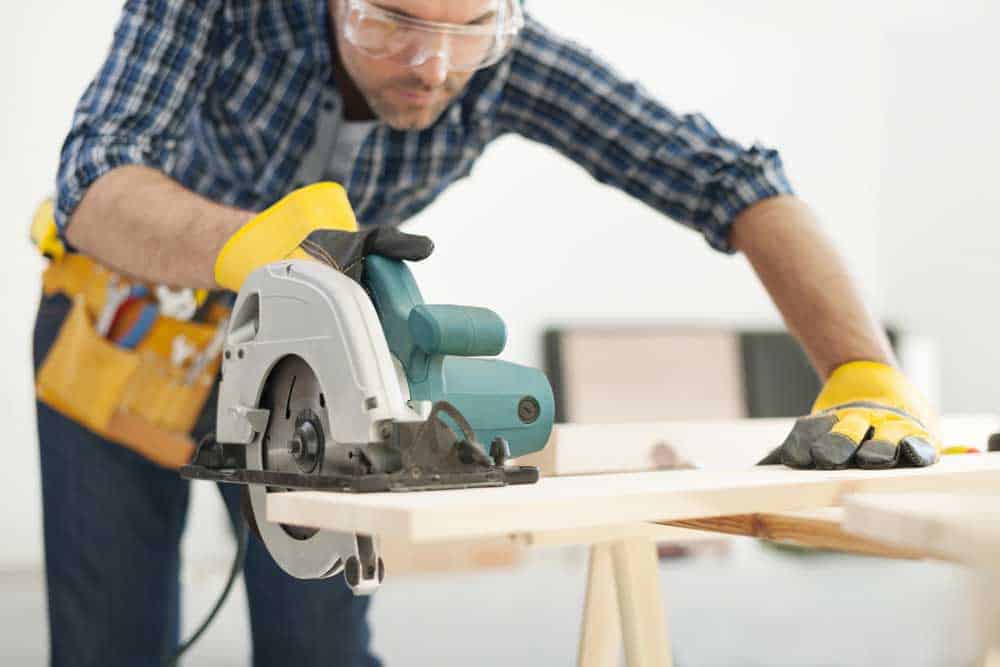“How loud is Cutting wood?” When it comes to woodworking and DIY projects, Cutting wood is a fundamental task.
Whether using a handsaw, circular saw, or a chainsaw, it’s important to consider the noise levels generated during the process.
In this blog post, we will highlight how loud cutting wood can be and provide some tips on how to protect your ears and manage the noise.
Wood cutting is a noisy endeavor, and for you to ensure your safety as well as the comfort of those around you, you will need to understand the decibel levels involved.
We measure the intensity of sound in decibels. It’s a logarithmic scale, which means that a small change in dB represents a significant change in sound intensity.
The level of noise produced when cutting wood with a particular saw type can vary depending on the type of wood, the Saw’s sharpness, and your cutting technique.

Working with a planer
What is a loud noise?
You classify a sound as noise when the volume becomes disturbing to the receiver.
Loud noises can be of different levels, but here are some common noise levels measured in decibels for reference.
- Normal conversation: 60 – 70 dB
- Lawnmower: 85-90 dB
- Rock concert: 110-120 dB
- Jet engine at takeoff: 130-140 dB
Noisy Machinery and Equipment
Most of your woodworking equipment makes a lot of noise during operation.
Here are some of the noisiest machines and equipment and how you can mitigate their volumes.
- Table saw: Table saw noise levels range between 90 to 110 dB. That is equivalent to the noise you would experience standing in a busy city traffic. You should consider purchasing a saw with built-in noise-dampening features. Also, invest in earmuffs or earplugs to help keep your hearing safe.
- Planer: Noise levels ranging from 95 to 110 dB. This is a startling amount of volume. If you are using a planer, then you definitely need some earmuffs or earplugs. You can also go for a modern planer with noise-reduction features.
- Router: Routers can be quite loud, generating noise levels of 85 to 100 dB. You will need hearing protection when working with a router machine. You can also reduce the noise level by reducing the machine speed.
- Dust collector: You should expect that a dust collector is necessary, considering the level of dust produced during wood cutting. But this equipment contributes to the noise in your workshop. Their noise levels range from 70 to 100 dB. It will help you to position your noise collector as far away from your work area as possible. But if you must work near the equipment, then ensure you wear something to protect your hearing.
- Jointer: Jointers can produce noise levels of 85 to 100 dB. You should opt for a jointer with noise-reduction features and also wear your hearing protection for more safety.

A man cutting wood with a table saw
Preventing Tinnitus and Other Damage
Tinnitus is when you experience ringing or other noises in one or both of your ears.
Too much exposure to loud noise can cause Tinnitus and, sometimes, hearing loss.
As a woodworker, you must take some necessary precautions to prevent developing this condition due to regular use of your noisy equipment. Here are some tips to prevent Tinnitus.
Use hearing protection: You must always wear over-the-ear hearing protection to reduce the level of noise penetrating your ear when cutting wood.
Take care of your cardiovascular health: You can take up regular exercise and also invest in good foods to keep your blood vessels healthy.
This can help prevent Tinnitus linked to obesity and blood vessel disorders.
Limit alcohol, caffeine, and nicotine intake: If you use these substances in excess, it will eventually lead to Tinnitus by affecting blood flow.

Pressure treated lumber
How long does it take for pressure-treated lumber to dry?
If you want to work with newly treated wood, I will advise you to give it enough time to dry in order to maximize its value properly.
After infusing a piece of lumber with preservatives, it becomes oversaturated with liquid, and therefore, it takes as long as three to four weeks to dry properly.
You have to understand that the drying time is different for different woods. You can consider other factors like the texture and type of wood, drying environment, and technique.
And You should also consider the amount of moisture in the lumber, which you can measure using a moisture meter.

A router machine
Conclusion
As a woodworker, working in a noisy environment is inevitable. But what you can do to ensure your safety is protect your hearing using the necessary protection aids.
Don’t forget that overexposure to loud sounds on a regular basis can cause some complications, such as Tinnitus or total loss of hearing.
You must follow the tips in this article to ensure your safety and the comfort of people around you.
